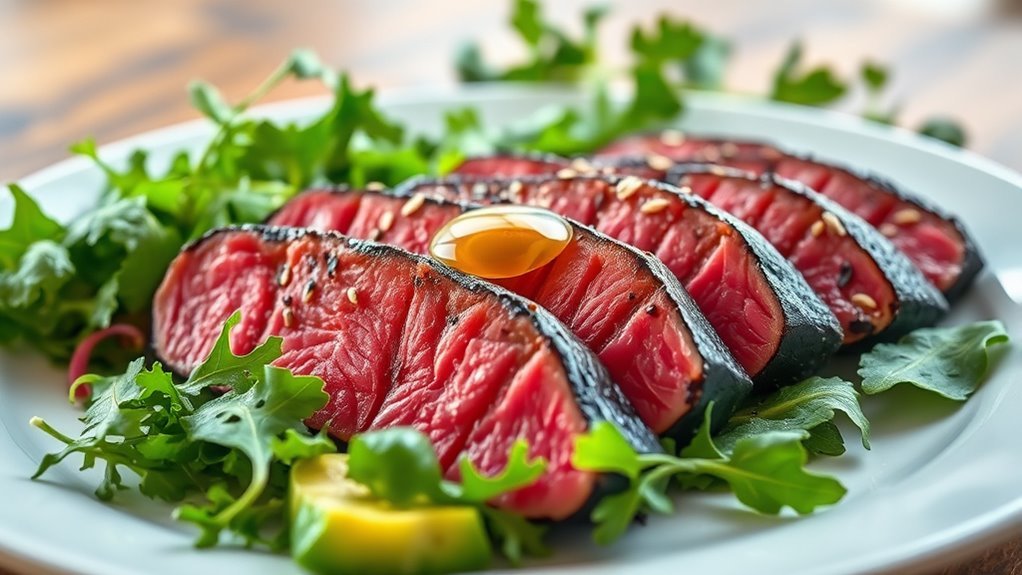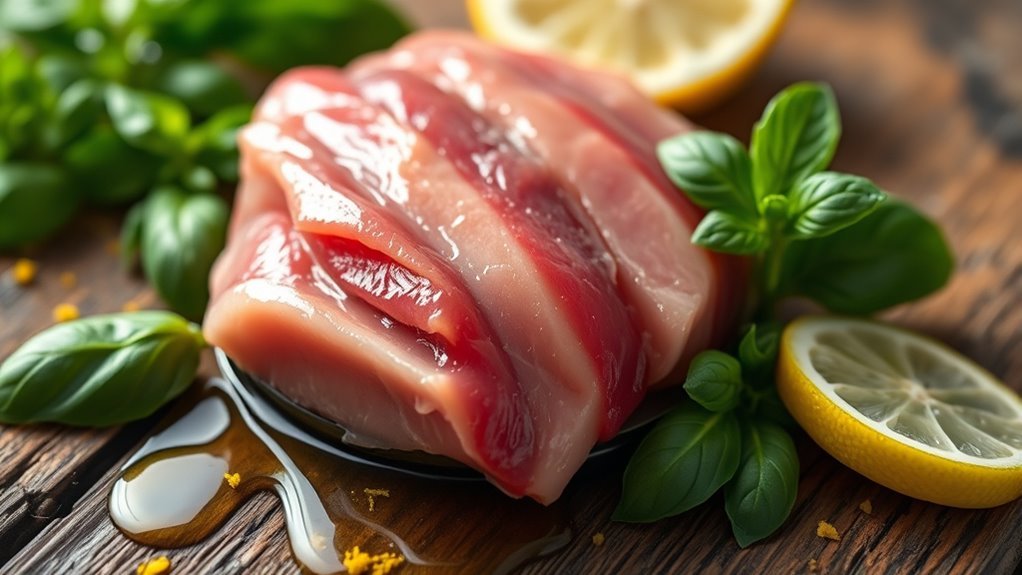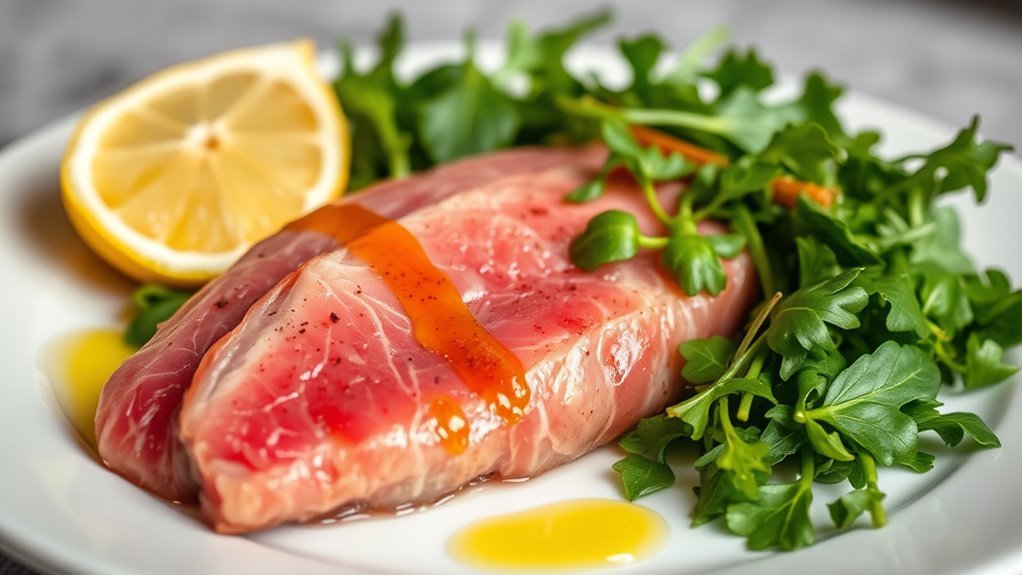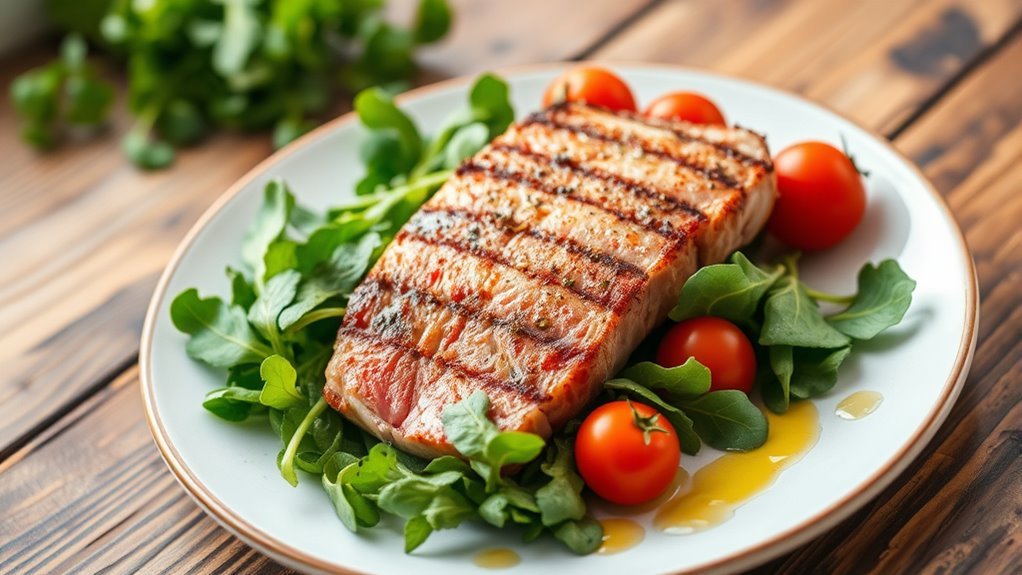Yes, tuna is keto-friendly. It’s low in carbohydrates, typically containing less than 1 gram per serving, and high in protein, offering around 20-25 grams per 3 ounces. Tuna also provides beneficial omega-3 fatty acids, promoting heart health. However, be mindful of mercury levels, especially in larger species, and consider sustainability when choosing your tuna. Want to explore ways to incorporate tuna into your meals and learn more about its benefits? Keep going!
Understanding the Nutritional Profile of Tuna

When it comes to evaluating the keto-friendliness of tuna, understanding its nutritional profile is crucial. Tuna is a low-carb protein source, making it an excellent choice for keto diets. It’s packed with omega-3 fatty acids, which are beneficial for heart health. However, you should be aware of tuna mercury levels, as certain species can accumulate higher concentrations, posing health risks if consumed excessively. Furthermore, consider tuna sustainability; overfishing and environmental impacts can affect tuna availability. Choosing sustainably sourced tuna not only supports ecological balance but also guarantees you’re making responsible dietary choices. Additionally, incorporating keto-friendly foods into your meals can enhance your overall diet while enjoying tuna. Balancing these factors allows you to enjoy tuna while aligning with your health goals and environmental values.
Types of Tuna and Their Carb Content

When considering tuna for a keto diet, it’s important to understand the different types available and their carb content. Canned tuna varieties, such as chunk light and solid white, may have slight variations in nutritional profiles, while fresh tuna options like ahi or yellowfin also offer distinct benefits. By examining the nutritional breakdown, you can make informed choices that align with your dietary goals.
Canned Tuna Varieties
Although you might be familiar with canned tuna as a quick and convenient source of protein, it’s important to understand the different varieties available and their carbohydrate content. Most canned tuna options, such as those from popular canned tuna brands, are low in carbs, making them suitable for a keto diet. You’ll typically find chunk light and solid white tuna, both of which contain negligible carbs. However, always check the label, as some products may contain added ingredients that increase carb counts. For ideal freshness, follow proper tuna storage tips—keep unopened cans in a cool, dry place, and refrigerate any opened cans. This way, you can enjoy the benefits of canned tuna while staying aligned with your dietary goals.
Fresh Tuna Options
While fresh tuna is a delicious and versatile option for those following a keto diet, it is essential to recognize the various types available and their carbohydrate content. Most fresh tuna varieties are low in carbs, making them suitable for your dietary needs. Here are some common types of fresh tuna:
- Bluefin Tuna: Known for its rich flavor and often used in sushi, it’s a high-quality choice.
- Yellowfin Tuna: Leaner than Bluefin, it’s perfect for grilling or searing.
- Albacore Tuna: Mild in flavor, it works well in salads or sandwiches.
- Bigeye Tuna: Similar to Yellowfin but with higher fat content, making it ideal for sushi grade dishes.
Each type offers unique textures and flavors, all while keeping your carb intake low.
Tuna Nutritional Breakdown
Understanding the nutritional breakdown of different tuna types is essential for anyone on a keto diet. Most tuna varieties, such as albacore or skipjack, are low in carbohydrates, typically containing less than 1 gram per serving, making them keto-friendly. When it comes to tuna protein content, you’ll find that it’s quite high, providing about 20 to 25 grams per 3-ounce serving. This protein is vital for maintaining muscle mass on a low-carb diet. Additionally, tuna is an excellent source of tuna omega 3 fatty acids, which support heart health and reduce inflammation. Incorporating different types of tuna into your meals can offer variety while keeping your carb intake in check. Enjoy the freedom of flavorful, nutritious options! Furthermore, tuna is rich in healthy fats, which can support overall heart health while adhering to keto guidelines.
Health Benefits of Tuna on a Keto Diet

Tuna offers numerous health benefits that align well with the principles of a keto diet, especially if you’re looking to maintain a low-carb lifestyle. Incorporating tuna into your meals can provide significant keto benefits, enhancing your overall tuna health. Here are some key advantages:
- High in Protein: Supports muscle maintenance and growth.
- Rich in Omega-3 Fatty Acids: Promotes heart health and reduces inflammation.
- Low in Carbs: Fits perfectly within the keto framework, helping you stay in ketosis.
- Packed with Vitamins and Minerals: Nutrients like vitamin D and selenium support overall health. Additionally, understanding the importance of healthy fats in your diet can further enhance the benefits of incorporating tuna into your meals.
How to Incorporate Tuna Into Your Keto Meals
Incorporating tuna into your keto meals can be both simple and delicious. You can try various tuna salad variations by mixing in keto-friendly ingredients like avocado, celery, or mayonnaise. Alternatively, a tuna casserole can provide a hearty option that aligns with your dietary goals while keeping flavor in focus.
Tuna Salad Variations
One of the simplest ways to enjoy tuna on a keto diet is by experimenting with various salad variations that align with your nutritional goals. Tuna salad can become a versatile meal prep option when you incorporate different ingredients and flavors. Here are some tasty ideas to try:
- Mediterranean style: Combine tuna with olives, feta, and a drizzle of olive oil.
- Avocado dressing: Swap mayonnaise for creamy avocado dressing for healthy fats.
- Greek yogurt twist: Use Greek yogurt instead of mayo for a protein boost and tangy flavor.
- Crunchy toppings: Add low carb additions like celery or nuts for satisfying crunch and texture.
Additionally, incorporating high-fat ingredients into your tuna salads can help enhance the overall flavor while keeping your carb intake low. You’ll enjoy delicious flavor combinations while staying on track with your keto lifestyle!
Tuna Casserole Recipes
Casseroles are a fantastic way to integrate tuna into your keto meals, offering a hearty and satisfying option that aligns with your dietary goals. A classic tuna casserole can be easily modified to fit keto requirements. Start with canned tuna, then add low-carb vegetables like spinach or zucchini. Instead of traditional pasta, consider using cauliflower rice or shirataki noodles. For creaminess, incorporate a blend of cream cheese and sour cream. You can also sprinkle cheese on top for added flavor and texture. These keto modifications not only keep the dish delicious but also maintain the necessary macros for your diet. With a little creativity, you can enjoy a comforting tuna casserole while staying true to your keto lifestyle. Remember to use healthy fats and oils to enhance flavor and support your keto journey.
Tuna Recipes Perfect for Keto
While many people think of tuna as just a quick lunch option, it can actually be a versatile ingredient for delicious keto-friendly meals. Here are some tasty ways to enjoy tuna on a keto diet:
- Tuna poke: Fresh and flavorful, perfect for a light meal.
- Tuna wraps: Use lettuce leaves instead of tortillas for a crunchy twist.
- Tuna tacos: Fill low-carb taco shells with your favorite toppings.
- Tuna dip: Serve with veggies or keto crackers for a satisfying snack.
You can also experiment with tuna burgers, tuna patties, or even tuna stir fry for a hearty dish. For something fun, try tuna skewers grilled to perfection. These recipes make it easy to incorporate tuna into your keto lifestyle!
Additionally, tuna is low in carbs and rich in protein, making it an excellent choice for those following a keto diet.
Potential Concerns With Tuna Consumption
Tuna can be a great addition to your keto meal plan, but it’s important to be aware of potential concerns associated with its consumption. One of the primary issues is mercury levels. Certain types of tuna, especially larger species like albacore, can contain higher mercury concentrations due to their position in the food chain. Regular consumption may pose health risks, particularly for pregnant women and young children. Additionally, sustainability issues are a concern. Overfishing and harmful fishing practices impact tuna populations and marine ecosystems. When choosing tuna, consider looking for sustainably sourced options to help mitigate these effects. Balancing health with environmental responsibility is vital, so stay informed and make choices that align with your values.
Comparing Tuna to Other Protein Sources
When considering protein sources for a keto diet, it’s essential to compare tuna with other options to understand its unique benefits and drawbacks. Here’s how tuna stacks up against some alternatives:
- High in Protein: Tuna boasts about 25 grams of protein per 100 grams, similar to salmon.
- Low in Fat: Tuna is leaner, offering lower fat content compared to fatty fish like salmon.
- Omega-3s: While tuna has omega-3s, salmon is superior, providing a richer source for heart health.
- Mercury Levels: Tuna generally has higher mercury levels than salmon, making frequency of consumption a consideration. Additionally, it’s important to note that shrimp is low in calories and high in protein, making it another excellent option for those on a keto diet.
Tips for Choosing the Right Tuna Products
Choosing the right tuna products can greatly impact your keto diet, especially since quality varies widely among brands and types. When selecting tuna, look for products with sustainable sourcing, as this guarantees you’re supporting environmentally friendly practices. Check labels for certifications like MSC or Dolphin Safe, which indicate responsible fishing methods. Additionally, pay attention to mercury levels; some tuna species, like albacore, tend to have higher mercury concentrations. Opt for light tuna, which typically contains lower mercury levels and offers a safer choice. Finally, consider whether you prefer canned, frozen, or fresh tuna, as each option has different preparation needs and flavors. By following these tips, you can enjoy tuna while staying aligned with your keto goals.
Frequently Asked Questions
Can I Eat Tuna Every Day on a Keto Diet?
Yes, you can eat tuna every day on a keto diet. Tuna’s benefits include being low in carbs and high in protein, making it a great choice for maintaining ketosis. However, moderation is key. Consider your daily intake of mercury from fish; while tuna is nutritious, consuming it daily might lead to excessive mercury levels. Balance it with other protein sources to guarantee a varied diet while enjoying tuna’s advantages.
Is Canned Tuna as Healthy as Fresh Tuna?
Canned tuna often gets a bad rap, but it’s not all doom and gloom. Regarding canned nutrition, it can be quite comparable to fresh tuna, providing valuable proteins and omega-3 fatty acids. While fresh tuna might boast some additional benefits like higher vitamin content, canned options are still a convenient, shelf-stable choice that can fit well into your diet. Ultimately, both forms can play a healthy role in your meals.
Does Tuna Contain Omega-3 Fatty Acids?
Yes, tuna does contain omega-3 fatty acids, which are vital for your health. Regarding tuna nutrition, these healthy fats offer numerous omega 3 benefits, including reducing inflammation, supporting heart health, and improving brain function. Whether you choose fresh or canned tuna, you’re getting a good source of these essential fatty acids. Incorporating tuna into your diet can be a delicious way to boost your omega-3 intake and support overall well-being.
Are There Any Mercury Concerns With Tuna Consumption?
Yes, there are mercury concerns with tuna consumption. Different tuna varieties have varying mercury levels; larger species like bluefin and albacore tend to accumulate more mercury than smaller ones like skipjack. It’s important to limit your intake, especially for pregnant women and children, due to potential health risks. Checking local advisories can help you make informed choices about how much and what type of tuna to eat while minimizing mercury exposure.
How Does Tuna Affect Cholesterol Levels?
So, imagine this: a tuna fish wearing a lab coat, analyzing your cholesterol levels. While it might sound absurd, tuna can actually be beneficial for heart health. It’s low in saturated fat and packed with omega-3 fatty acids, which can help improve cholesterol levels. Eating tuna in moderation may even boost your HDL (good cholesterol). Just remember, balance is key—too much of anything, even this fishy friend, could lead to other health concerns!


